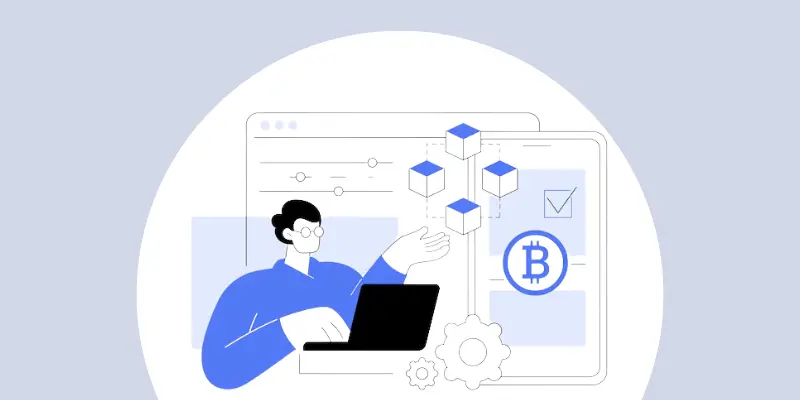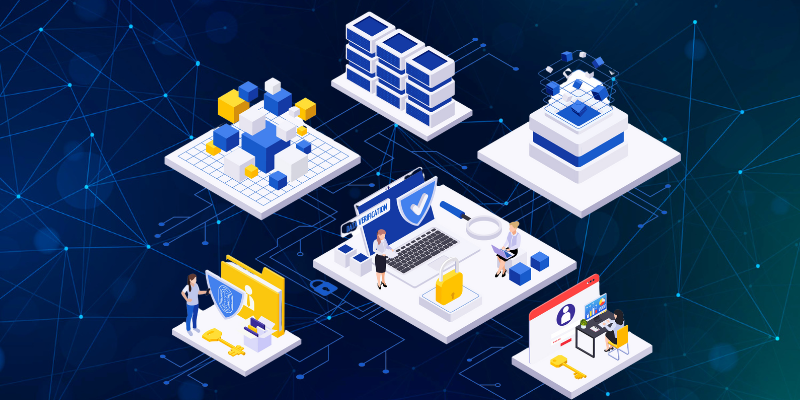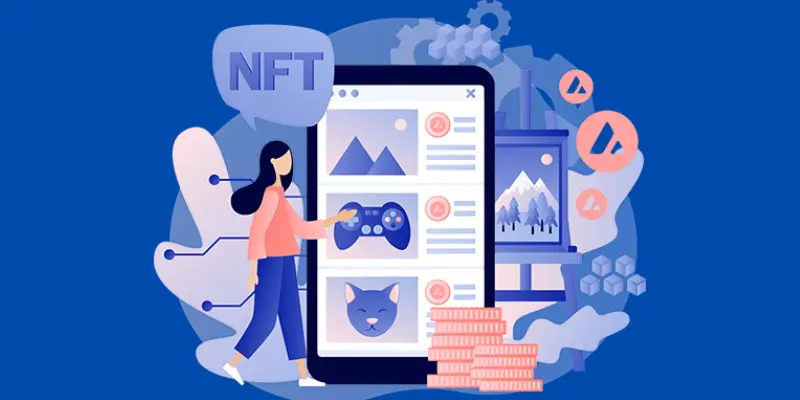Recently, the world of finance has seen a substantial change thanks to the advent of Decentralized Finance (DeFi). This revolution has led to a new age of financial services that are free of traditional intermediaries. Developing decentralized financial applications, known as DeFi Development, involves building apps using blockchain networks. It encompasses a broad spectrum of technical and non-technical tasks, which includes:
-
Blockchain technology: DeFi applications are based on decentralized, safe, and affluent blockchain networks. The most used blockchains for DeFi token development include Ethereum, Binance Smart Chain, and Solana.
-
Tokens are typically used to symbolize assets such as bonds, coins, and derivatives in DeFi apps. Tokens are generated through a process known as tokenization, which is when you issue the digital representation of an asset on the blockchain.
-
Utilization cases: DeFi apps have a broad range of applications, which include:
-
Staking: Staking refers to locking crypto tokens to collect rewards.
-
Borrowing and lending: DeFi's loans and lending platforms permit users to borrow and lend cryptocurrency without needing a centralized intermediary.
-
Trade: DeFi trading platforms allow customers to trade cryptocurrency and various other assets digitally.
-
The Derivatives: DeFi derivative platforms let users trade financial instruments, including Futures or options.
-
App development: DeFi apps are typically developed using decentralized applications (dApps), which operate on blockchains and are not managed by a single entity.
-
The key players in the industry: The DeFi industry is in its infancy stages. However, several essential players are driving the industry's growth. They include:
-
Ethereum, Binance Smart Chain, and Solana are the core infrastructure for DeFi-related applications.
-
DeFi projects are the developers who create the DeFi applications.
-
DeFi investor: DeFi investors are the people and institutions that invest in DeFi projects.
Defi Development is a rapidly expanding field with many options for those interested. Numerous websites offer resources for learning more about DeFi Development.
Understanding DeFi Development
At its heart, DeFi token Development leverages blockchain technology to build a secure and transparent financial environment. We examine the significance of blockchain technology, which is the backbone that guarantees safe, unalterable, and decentralized transactions.
Defi Blockchain Development
DeFi is a short form of Decentralized Finance based on blockchain technology to build an open and secure financial system. Blockchain forms the basis of DeFi, which ensures security, immutability, and decentralized transactions.
DeFi apps are built on blockchains. Blockchains are distributed ledgers that keep a trail of transactions safe and tamper-proof. This means that there is no requirement for a central agency like a bank or a government agency to validate the authenticity of transactions. DeFi services are more effective and transparent than traditional financial services.
DeFi applications offer various financial services like trading, lending, and investing. These services have lower costs than traditional banking services and are usually accessible 24 hours a day. DeFi services are also much more user-friendly than conventional financial products since they can be accessed from any computer connected to the Internet.
DeFi is a new technology, but it could transform the financial sector. DeFi-based applications provide a range of benefits over conventional financial products, such as efficiency, transparency, security, and accessibility. As it grows, DeFi will take on a more significant role in the finance system.
Defi Token Development
Tokens are one of the fundamental elements of DeFi. Tokens are the vital building blocks of the DeFi ecosystem. They symbolize value, facilitate transactions, and oversee decentralized applications (DApps). There are a variety of tokens utilized in DeFi, such as:
-
Stablecoins are tokens tied to a fixed currency like the US dollar. They are utilized to ensure some stability in the deflation market.
-
The tokens for governance allow holders the right to participate in the process of making decisions for the DApp.
-
Utility tokens: The tokens give access to functions or other services.
Security tokens symbolize tangible asset ownership, such as a company or piece of real property.
DeFi Token Development involves developing new tokens that can be used in the DeFi ecosystem. The process is often complex and requires smart contracts and blockchain technology knowledge. However, it is vital to the ongoing expansion and growth of the DeFi ecosystem.
Tokens play a significant role in determining the financial instruments used to power DApps inside the DeFi ecosystem. In particular, stablecoins can be used to supply liquidity for trading pairs. Governance tokens enable users to partake in the decision-making process for the DApp, and utility tokens can be utilized to grant access to the DApp's features and services.
The DeFi ecosystem is continually growing, as new coins are constantly being created. As the DeFi community expands, DeFi Token Development will become a more significant part of the blockchain world.
Uses of Decentralized Finance
DAOs in synthetic assets and decentralized financial protocols have opened up a new world of economic opportunities for everyone. DeFi is a massive and well-coordinated effort to build a new financial platform on Ethereum that can rival centralized ones in terms of access, reliability, and transparency. The extensive list of uses listed below demonstrates this.
The most critical DeFi cases of use are:
Asset Management
Users have greater control over their accounts through DeFi. However, most of the most well-known DeFi initiatives allow consumers to buy or sell digital products. Thus, consumers can earn income from the digital items they own. Furthermore, unlike traditional banking, DeFi lets clients keep confidential information. Look at the private keys or passwords to your bank accounts: you must disclose this information to pertinent firms in advance. Therefore, asset management is among the most beneficial applications for financial management that is decentralized and accessible to customers.
Compliance and Know Your Customer
Know-your-customer (KYC) procedures are a significant focus in traditional banking systems. However, the most crucial compliance tool in carrying out anti-money laundering (AML) and counter-terrorist finance (CFT) methods is the Know Your Customer (KYC) regulation. In the same way, KYC regulations often collide with DeFi's privacy policies. Additionally, DeFi tackles this issue by using the Know-Your-Transaction (KYT) technique, a more contemporary concept. This suggests decentralized infrastructure could be more concerned with transaction behavior and digital addresses than users' identities.
DAOs
DAOs, also called Decentralized Autonomous Organizations, are the equivalent of central financial institutions that are part of DeFi development and are one of the mainstays of decentralized finance applications. In the past model, central financial institutions played an important function. These organizations function as administrative bodies that oversee fundamental financial functions like managing assets, fundraising, and implementing governance. However, DAOs are decentralized and do not abide by the guidelines set by central agencies or government officials.
Data Analytics
Through openness and decentralization, people can access and analyze previously undiscovered information. With access to this data, users can make well-informed decisions in their business, explore new financial opportunities, and boost risk management methods. This shift in industry has led to an innovative data analytics method packed with blockchain-based applications and tools. In the same way, DeFi initiatives like DeFi Pulse and CoDeFi Data offer powerful analytics as well as the benefits of risk management.
Derivatives
Using smart contracts to create tokenized derivatives has been a fascinating DeFi application case. Tokenizing derivatives, in contrast, is the method of determining its value based on an asset that is the basis for the contract (or group of assets). Additionally, the tokenization of derivatives has been considered secondary security, and their value fluctuates in relation to the worth of primary security (bonds as well as fiat currencies).
Infrastructure equipment
Composability is among the main design principles of DeFi protocols. This means that different system components can interact and join each other easily. Many people associate DeFi development with the construction of Legos. With Truffle's smart contracts libraries, Infura's API suite, and Diligence's security software, Ethereum teams, and developers are now able to build and implement DeFi protocols using the complete stack of tools and security integrations they'll need.
Digital identity
In recent times, digital IDs based on blockchain have been gaining popularity. But, integrating them with the DeFi protocols will facilitate their entry into the global economy. The new digital identity will also allow less fortunate people to access DeFi services in any Internet area. Additionally, it could be one of the potential scenarios for use.
Insurance
Insurance is a major business in the financial sector and is also among the most well-known DeFi-related use cases reported currently. Certain insurance options are being developed to assist clients in getting coverage and protecting their investments. Furthermore, should smart contracts be successful, the current system's shortcomings could be addressed.
Challenges Facing DeFi Projects: DeFi Is Revolutionary, but It Has Limits
.webp)
DeFi is becoming a widespread phenomenon, accompanied by many issues. It is a relatively new concept that hasn't been tested under extensive or long-term usage pressures. Furthermore, authorities nationwide are examining the methods they have implemented in the interest of regulation. Other threats that are associated with DeFi development include:
There are no consumer protections.
With no regulations and rules, DeFi has blossomed. But, this means that customers may have little recourse when an operation goes wrong. In centralized finance, for instance, the Federal Deposit Insurance Corporation (FDIC) provides deposit account holders with as much as $250,000 for each account for each institution in case of a bank's failure. Additionally, banks are required by law to hold a specific part of their capital in reserves to ensure stability. They also allow customers to withdraw money anytime. There aren't any such protections in DeFi smart contract development.
Hackers pose a risk
Although it is impossible to update the blockchain, other parts of DeFi are very vulnerable to hacking and could cause the destruction or theft of money. Every possible use case that relies on decentralized finance depends on systems with vulnerable software.
Collateralization
Collateral is an asset that can be used to ensure the loan. When you apply for a mortgage, for example, it is backed by the home being bought. Nearly all DeFi loans require collateral greater than 100% of the loan's worth. The rules severely limit the amount of collateral that can be used for various types of DeFi-backed loans.
Private important requirements
With DeFi and other cryptocurrencies, you must secure the bitcoin accounts you have. Private keys are lengthy, unique, exclusive codes that are only known to the wallet's owner. They are used to secure wallets. When you are unable to access your private keys, you cannot access your account. The lost private key can't be found.
Protocol risk
Most of the time, DeFi smart contracts development stores large amounts of cryptocurrency. This provides a significant incentive to look for weaknesses in code. These vulnerabilities in poorly designed codes have been exploited multiple times, often putting users of the programs affected out of their pockets. Additionally, criminals can distribute malicious code to trick innocent DeFi users.
Risk of Composability
The interconnectivity of DeFi protocols means that vulnerabilities can only surface when several protocols are utilized simultaneously.
Rug pulls
A few lesser DeFi projects have pulled the rug from the early adopters. The project's developers drain a liquidity pool to gain from their customers' liquidity.
Risks posed by regulation
The standard financial sector is heavily regulated to protect investors and prevent financial crimes like laundering money. Defi, on the other hand, is totally unregulated. A severe regulatory crackdown will surely harm the still-growing subsector.
Centralization risk
Certain DeFi platforms and their ecosystems can be more centralized than others. For instance, some protocols include master keys and other features that allow developers complete control over their projects. These features are intended to protect the protocol users. However, they can even be utilized to close the project completely in the event that regulators put enough pressure on it.
Volatility
Even the most expensive DeFi coins can be unpredictable. Unpredicted price volatility could result in significant losses for DeFi users.
The Future of DeFi
The future for DeFi token development promises to be bright and cheerful, with its continuing growth and user gain. Here are a few developments and forecasts regarding DeFi's future.
-
Greater Adoption: DeFi is in its beginning stages, and its potential has yet to be fully realized. As more people become aware of its advantages, including lower costs, faster transactions, and more access, the adoption of DeFi is expected to rise dramatically.
-
Integration with traditional Finance: DeFi is poised to shake up traditional finance by providing more affordable and comprehensive financial services. As DeFi expands, it will incorporate more into conventional finance, increasing investment and adoption.
-
The Regulatory Challenges: Due to its growing popularity, secure DeFi wallet development is likely to be subject to greater scrutiny from regulators. This could pose problems for DeFi projects and may lead to the creation of new regulatory frameworks designed explicitly for DeFi.
-
Exploration and Innovation: DeFi is a rapidly changing market, and the latest innovations and research are likely to continue to develop. This could result in developing innovative and new DeFi solutions and products that will revolutionize the financial sector.
-
Expansion of the DeFi Ecosystem: It is predicted to grow, with new protocols and projects being created to tackle different scenarios and issues. This could result in increased collaboration and interoperability across the entire DeFi ecosystem.
Conclusion
These trends create a captivating image of the dynamic DeFi landscape. From integrating traditional financial instruments to changing the game sector, DeFi development is continuously pushing boundaries and changing the finance landscape. As these changes continue in the coming years, we can expect more creative ideas to emerge, further strengthening DeFi's place as a significant factor in the future of finance.
By embracing these developments, DeFi is set to enter a new era of growth and development. With the potential to establish an open, inclusive, and efficient banking system, DeFi will be an area to be watched for the next few years.






.webp)







Share this blog